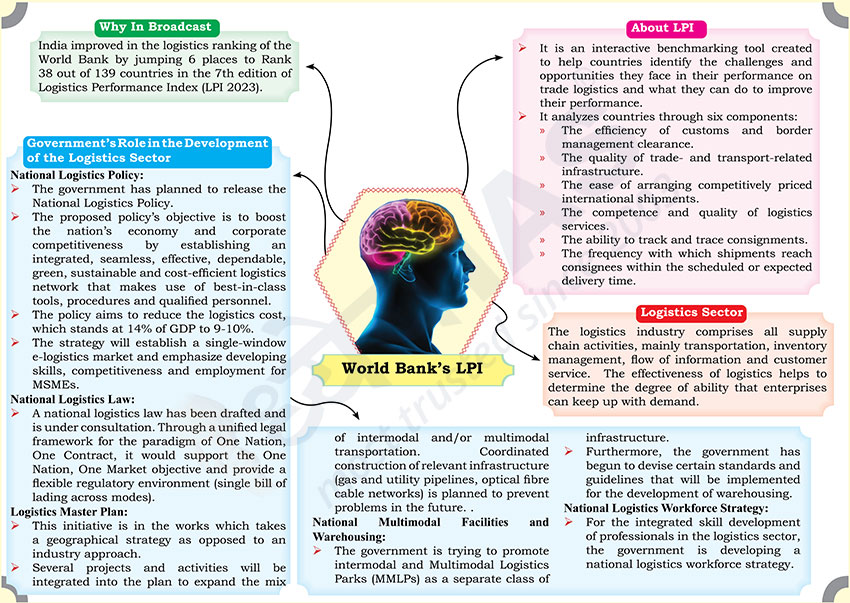Brain-booster /
01 Jun 2023
Brain Booster for UPSC & State PCS Examination (Topic: World Bank’s LPI)

Why in Broadcast?
- India improved in the logistics ranking of the World Bank by jumping 6
places to Rank 38 out of 139 countries in the 7th edition of Logistics
Performance Index (LPI 2023).
About LPI
- It is an interactive benchmarking tool created to help countries
identify the challenges and opportunities they face in their performance on
trade logistics and what they can do to improve their performance.
- It analyzes countries through six components:
- The efficiency of customs and border management clearance.
- The quality of trade- and transport-related infrastructure.
- The ease of arranging competitively priced international shipments.
- The competence and quality of logistics services.
- The ability to track and trace consignments.
- The frequency with which shipments reach consignees within the
scheduled or expected delivery time.
Logistics Sector
- The logistics industry comprises all supply chain activities, mainly
transportation, inventory management, flow of information and customer
service. The effectiveness of logistics helps to determine the degree of
ability that enterprises can keep up with demand.
Government’s Role in the Development of the Logistics Sector
National Logistics Policy:
- The government has planned to release the National Logistics Policy.
- The proposed policy’s objective is to boost the nation’s economy and
corporate competitiveness by establishing an integrated, seamless,
effective, dependable, green, sustainable and cost-efficient logistics
network that makes use of best-in-class tools, procedures and qualified
personnel.
- The policy aims to reduce the logistics cost, which stands at 14% of GDP
to 9-10%.
- The strategy will establish a single-window e-logistics market and
emphasize developing skills, competitiveness and employment for MSMEs.
National Logistics Law:
- A national logistics law has been drafted and is under consultation.
Through a unified legal framework for the paradigm of One Nation, One
Contract, it would support the One Nation, One Market objective and provide
a flexible regulatory environment (single bill of lading across modes).
Logistics Master Plan:
- This initiative is in the works which takes a geographical strategy as
opposed to an industry approach.
- Several projects and activities will be integrated into the plan to
expand the mix of intermodal and/or multimodal transportation. Coordinated
construction of relevant infrastructure (gas and utility pipelines, optical
fibre cable networks) is planned to prevent problems in the future. .
National Multimodal Facilities and Warehousing:
- The government is trying to promote intermodal and Multimodal Logistics
Parks (MMLPs) as a separate class of infrastructure.
- Furthermore, the government has begun to devise certain standards and
guidelines that will be implemented for the development of warehousing.
National Logistics Workforce Strategy:
- For the integrated skill development of professionals in the logistics
sector, the government is developing a national logistics workforce
strategy.








